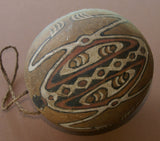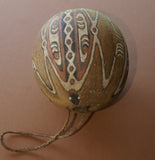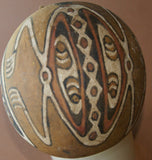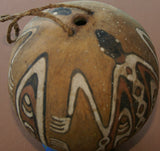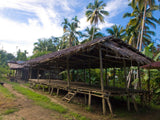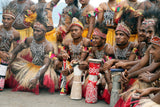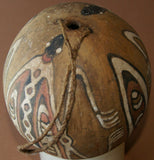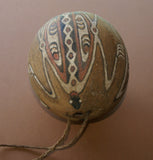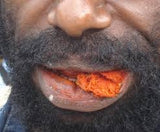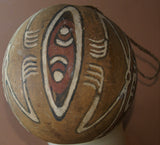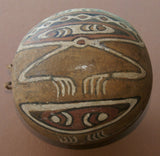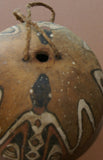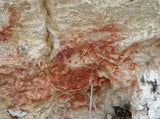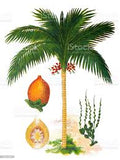BETEL PARAPHERNALIA: ETHNIC VERY RARE PRIMITIVE LIME GOURD, HAND PAINTED TRADITIONAL MOTIFS CREATED WITH NATURAL PIGMENTS (CHARCOAL & LIME), COLLECTED ON THE PREMISES, LAKE SENTANI, WEST PAPUA, IRIAN JAYA, LATE 1900'S.
THESE ETHNIC PRIMITIVE LIME GOURDS ARE VERY RARE AND HARD TO LOCATE, WE NEVER FOUND BUT 2 AVAILABLE IN THE SENTANI LAKE REGION. COLLECTED ON THE PREMISES IN THE LATE 1900’S.
Extremely rare & very decorative Hand carved & Hand painted Lime Gourd Receptacle from Lake Sentani, Irian Jaya, West Papua. The nice traditional designs from the region that decorate it were created with natural dyes such as charcoal and lime. A hand twisted twine made of bark or plant material allowed it to hang from a man’s belt.
SIZE APPROXIMATELY: 6” x 6” and 17” all around.
ITEM GOU2.
THE TRADITIONAL LAKE SENTANI COLORS & MOTIFS REPRESENT 2 LARGE BEETLES SPACED AT INTERVALS WITH 2 MINIATURE CANOE SHAPED MOTIFS. LOVELY PIECE.
WE ALSO CARRY CUSTOM MADE METAL HANDCRAFTED STANDS TO DISPLAY GOURDS, BASKETS AND POTTERY ETC..., FOR SALE HERE AS WELL, MANY SIZES AND HEIGHTS AVAILABLE.
Betel chewing, mixed with lime, (produced by heating shells) is a central part of life in East New Guinea and the nearby Islands as well. The powdered mineral lime is chewed with betel nut. Alkaloids are released from the combination producing a mildly intoxicating effect. Children even start chewing when they are a few years of age. Betel chewing is a light stimulant which reduces hunger pangs and produces a feeling of good humor, well- being, and an increased capacity for work. The utensils used for storing and chewing consist of lime containers, mortar and pestles to crush the betel nuts and lime spatulas that convey the lime to the mouth. All these items are decorated, the finest however being the work done on spatulas and gourds. Some spatulas carry representations of highly stylized human figures, plants, or animals, and gourds are etched with motifs. Great care is taken in the time consuming designs and details which represent the owner’s status.
In West Papua (Irian Jaya), people of the interior have only moved out of the Stone Age in the last 30-40 years. Up until the 1960’s stone tools were the norm. It wasn't until steel was introduced to them by outsiders that steel axe heads, knife blades, etc. became more common. Before that stone axe heads and bone knives were all they had. In the south, headhunting and cannibalism were also common up until a generation or two ago. Some parts of Irian Jaya are still not truly explored and maps often have blank spots where there is not enough information available to fill in the details.
THE VERY FEW FROM THAT REGION I HAVE LOCATED FOR SALE ON THE INTERNET OR ELSEWHERE, WERE OVER $1,000.00 EACH, MAYBE BECAUSE THEY ARE SO HARD TO FIND FOR PURCHASE.
All our collector and rare items come with pages and pages of research about provenance, and with history of the tribes and photos as well, depending on item and whenever possible. When shipping internationally, we group ship multiple purchases to save you money, and find the best rates available. If you have any questions or want to see research conducted on this piece and photos of tribes, let us know.













































